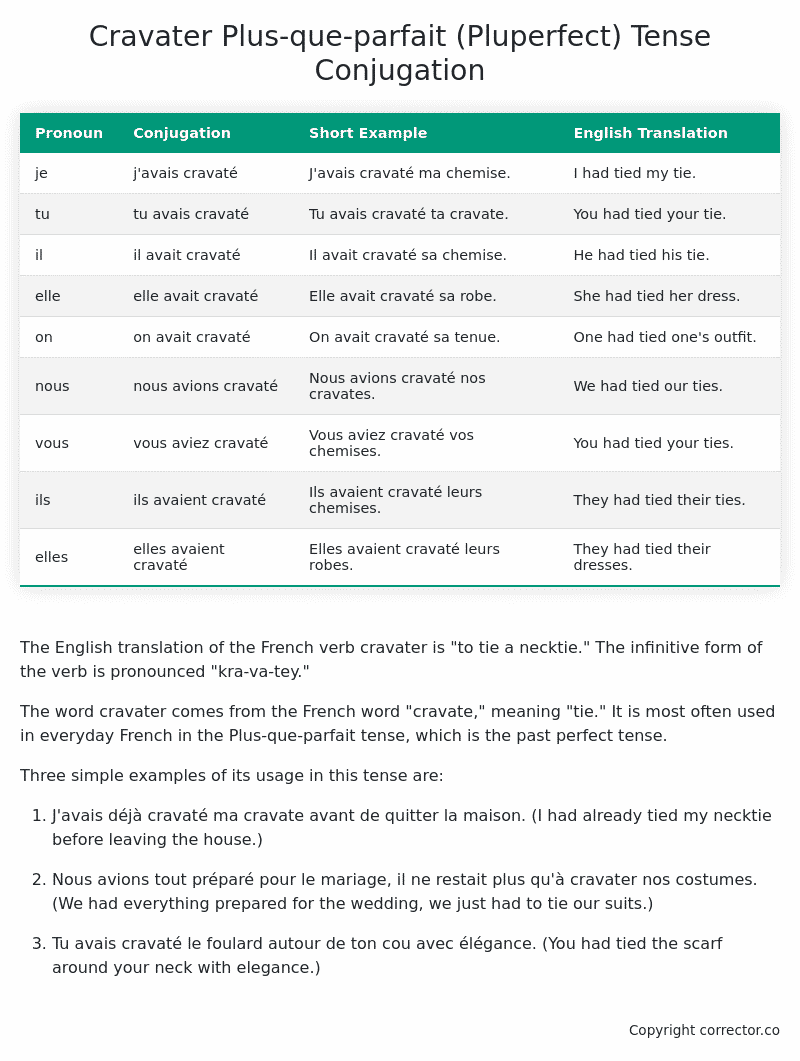Plus-que-parfait (Pluperfect) Tense Conjugation of the French Verb cravater
Introduction to the verb cravater
The English translation of the French verb cravater is “to tie a necktie.” The infinitive form of the verb is pronounced “kra-va-tey.”
The word cravater comes from the French word “cravate,” meaning “tie.” It is most often used in everyday French in the Plus-que-parfait tense, which is the past perfect tense.
Three simple examples of its usage in this tense are:
-
J’avais déjà cravaté ma cravate avant de quitter la maison. (I had already tied my necktie before leaving the house.)
-
Nous avions tout préparé pour le mariage, il ne restait plus qu’à cravater nos costumes. (We had everything prepared for the wedding, we just had to tie our suits.)
-
Tu avais cravaté le foulard autour de ton cou avec élégance. (You had tied the scarf around your neck with elegance.)
Table of the Plus-que-parfait (Pluperfect) Tense Conjugation of cravater
| Pronoun | Conjugation | Short Example | English Translation |
|---|---|---|---|
| je | j’avais cravaté | J’avais cravaté ma chemise. | I had tied my tie. |
| tu | tu avais cravaté | Tu avais cravaté ta cravate. | You had tied your tie. |
| il | il avait cravaté | Il avait cravaté sa chemise. | He had tied his tie. |
| elle | elle avait cravaté | Elle avait cravaté sa robe. | She had tied her dress. |
| on | on avait cravaté | On avait cravaté sa tenue. | One had tied one’s outfit. |
| nous | nous avions cravaté | Nous avions cravaté nos cravates. | We had tied our ties. |
| vous | vous aviez cravaté | Vous aviez cravaté vos chemises. | You had tied your ties. |
| ils | ils avaient cravaté | Ils avaient cravaté leurs chemises. | They had tied their ties. |
| elles | elles avaient cravaté | Elles avaient cravaté leurs robes. | They had tied their dresses. |
Other Conjugations for Cravater.
Le Present (Present Tense) Conjugation of the French Verb cravater
Imparfait (Imperfect) Tense Conjugation of the French Verb cravater
Passé Simple (Simple Past) Tense Conjugation of the French Verb cravater
Passé Composé (Present Perfect) Tense Conjugation of the French Verb cravater
Futur Simple (Simple Future) Tense Conjugation of the French Verb cravater
Futur Proche (Near Future) Tense Conjugation of the French Verb cravater
Plus-que-parfait (Pluperfect) Tense Conjugation of the French Verb cravater (this article)
Passé Antérieur (Past Anterior) Tense Conjugation of the French Verb cravater
Futur Antérieur (Future Anterior) Tense Conjugation of the French Verb cravater
Subjonctif Présent (Subjunctive Present) Tense Conjugation of the French Verb cravater
Subjonctif Passé (Subjunctive Past) Tense Conjugation of the French Verb cravater
Subjonctif Imparfait (Subjunctive Imperfect) Tense Conjugation of the French Verb cravater
Subjonctif Plus-que-parfait (Subjunctive Pluperfect) Tense Conjugation of the French Verb cravater
Conditionnel Présent (Conditional Present) Tense Conjugation of the French Verb cravater
Conditionnel Passé (Conditional Past) Tense Conjugation of the French Verb cravater
L’impératif Présent (Imperative Present) Tense Conjugation of the French Verb cravater
L’infinitif Présent (Infinitive Present) Tense Conjugation of the French Verb cravater
Struggling with French verbs or the language in general? Why not use our free French Grammar Checker – no registration required!
Get a FREE Download Study Sheet of this Conjugation 🔥
Simply right click the image below, click “save image” and get your free reference for the cravater Plus-que-parfait tense conjugation!

Cravater – About the French Plus-que-parfait (Pluperfect) Tense
Tense Formation
Common everyday usage patterns
Sequencing of past events
Background information
Hypothetical or reported speech
Interactions with other tenses
Summary
I hope you enjoyed this article on the verb cravater. Still in a learning mood? Check out another TOTALLY random French verb conjugation!


